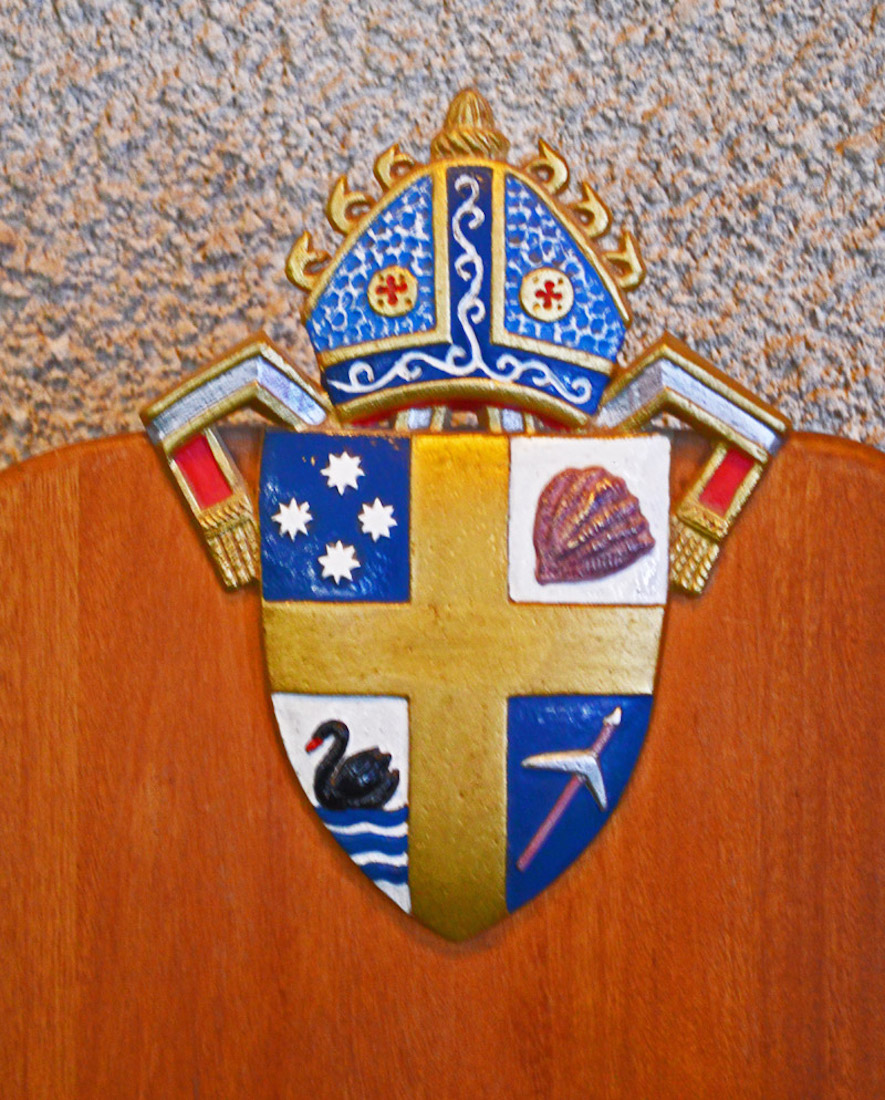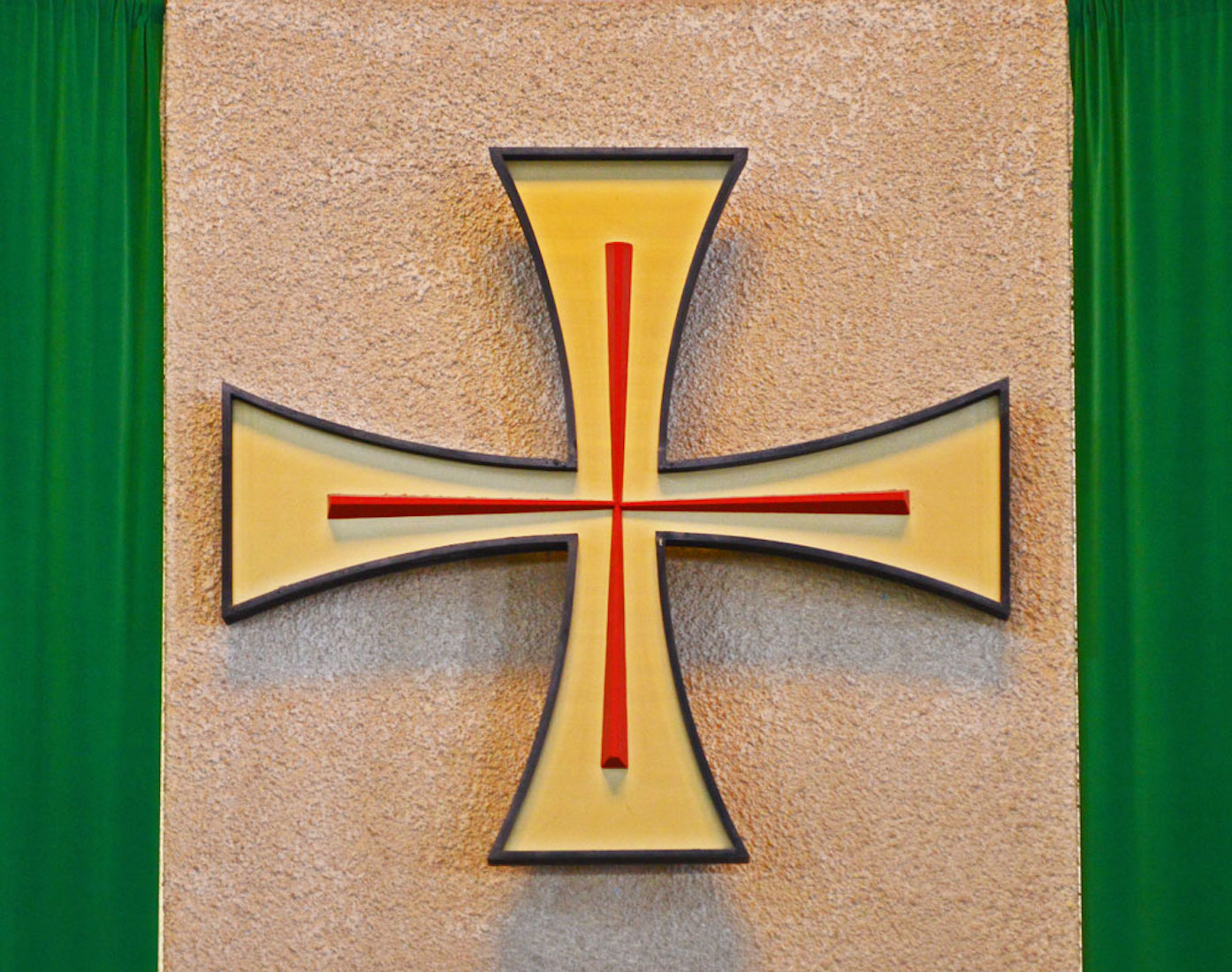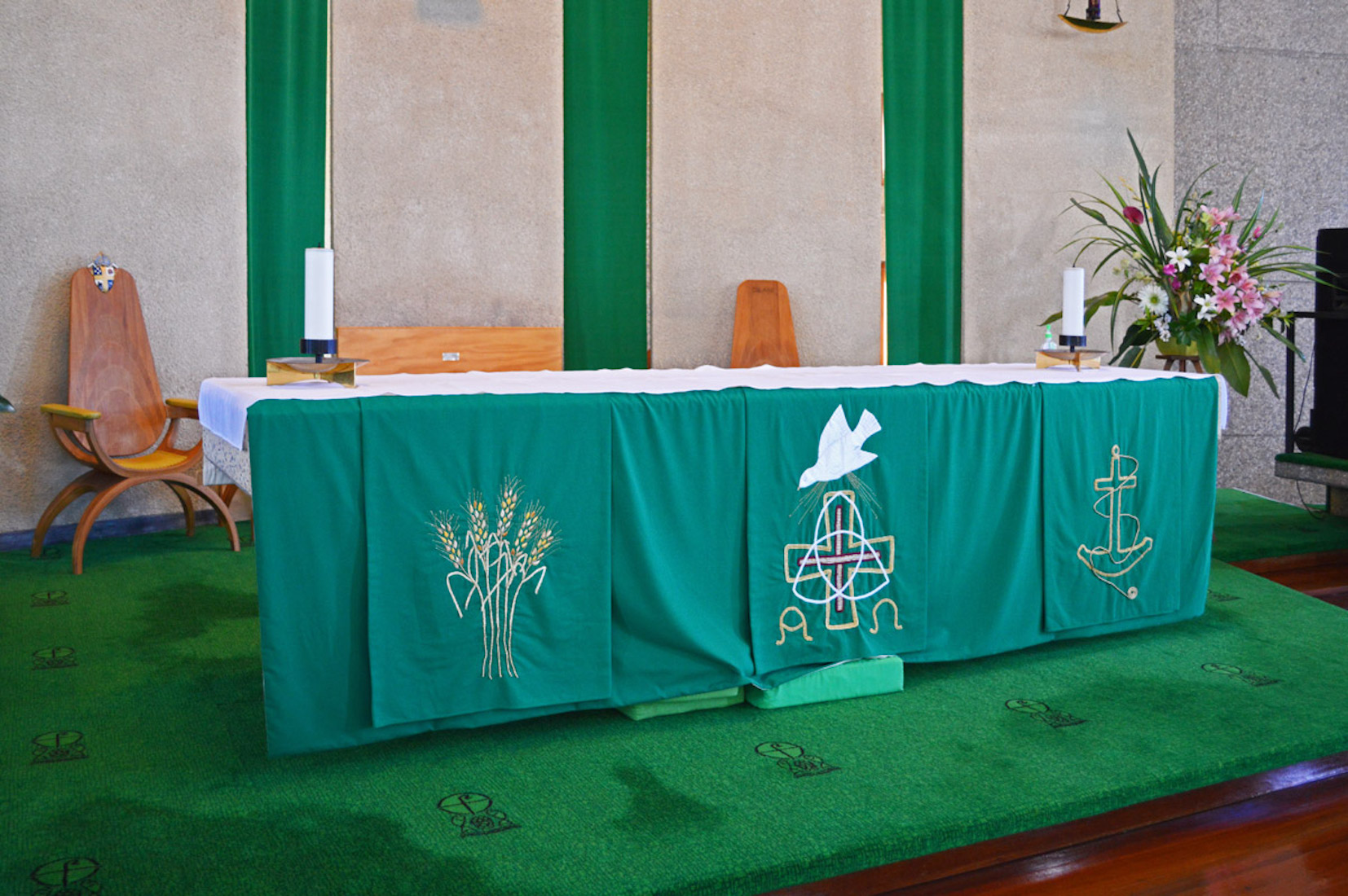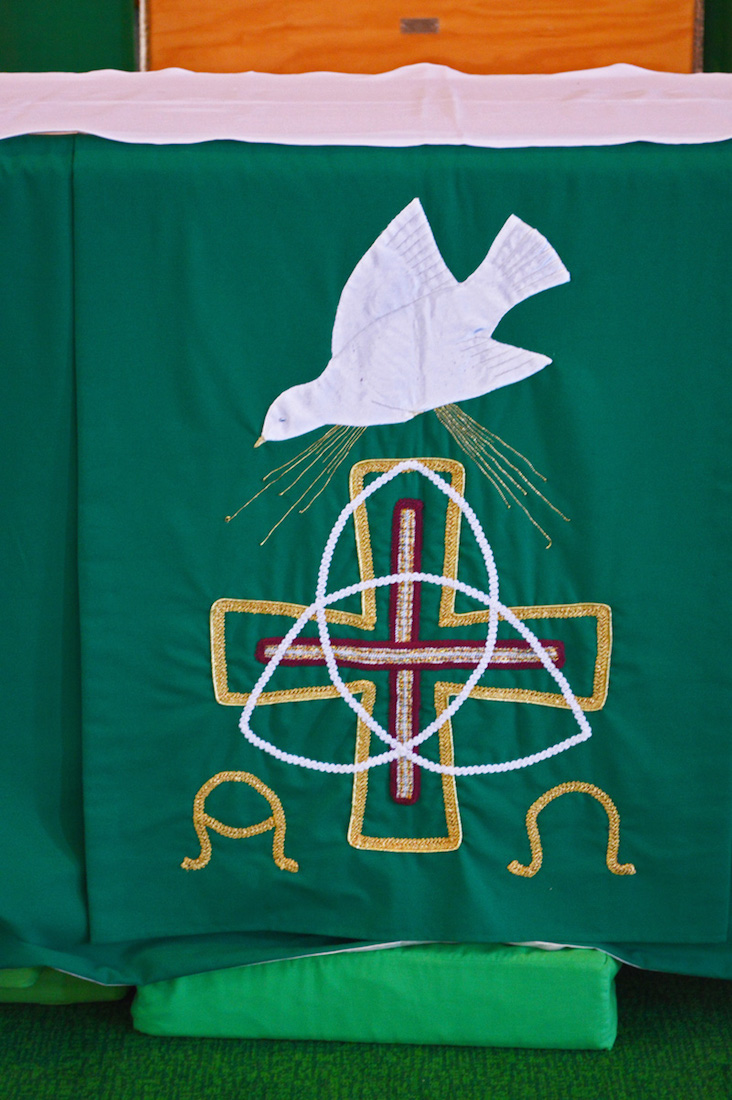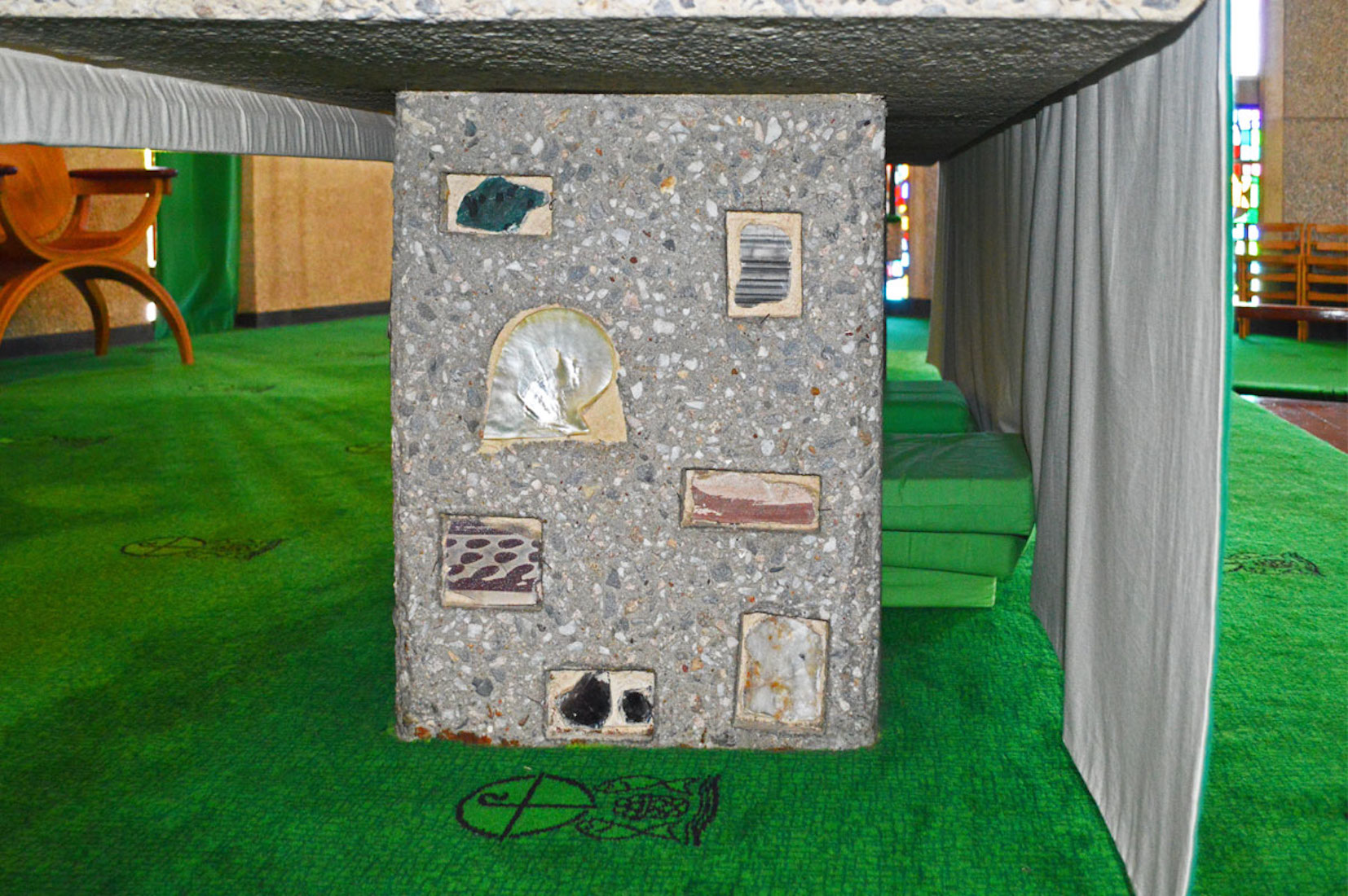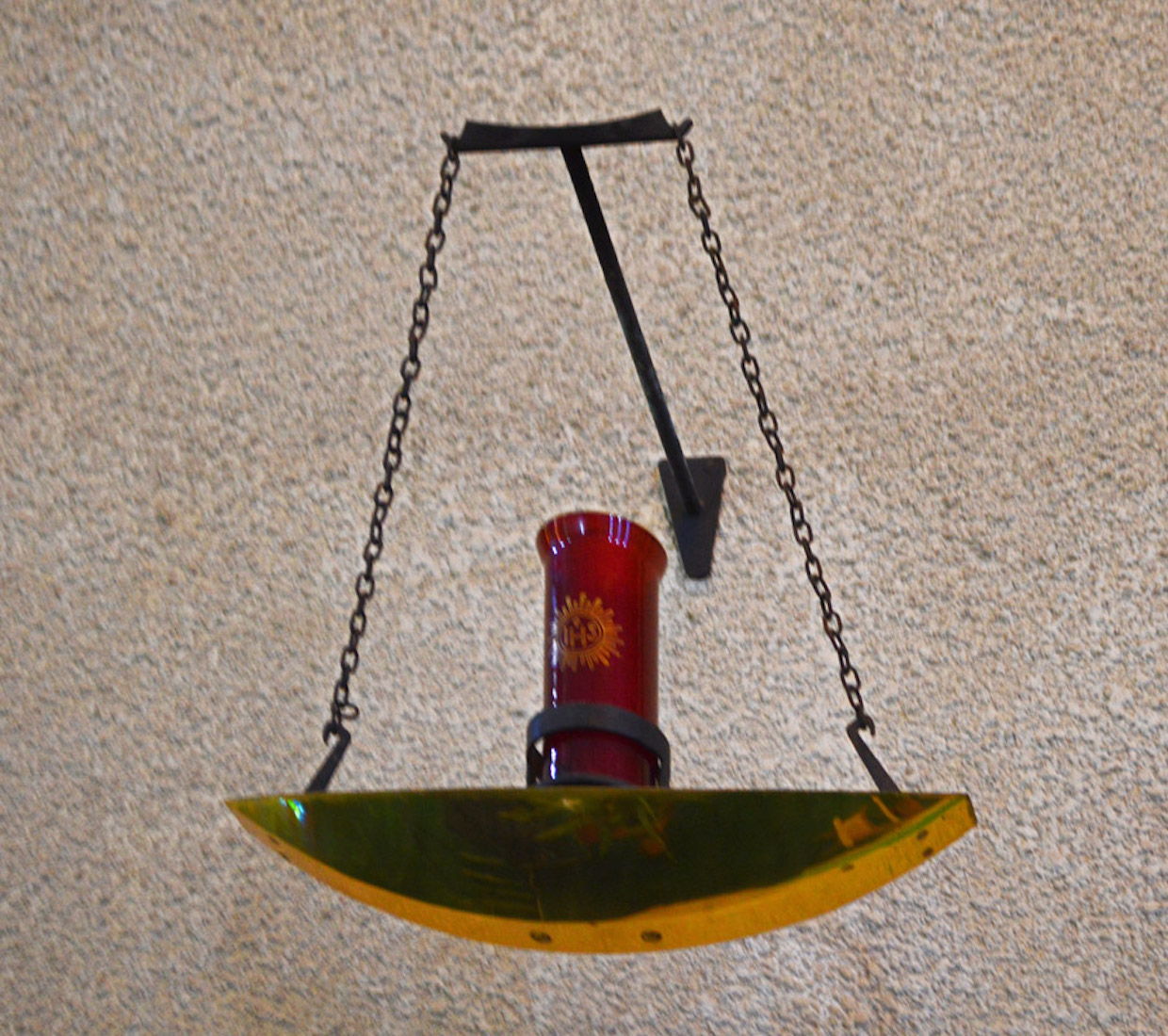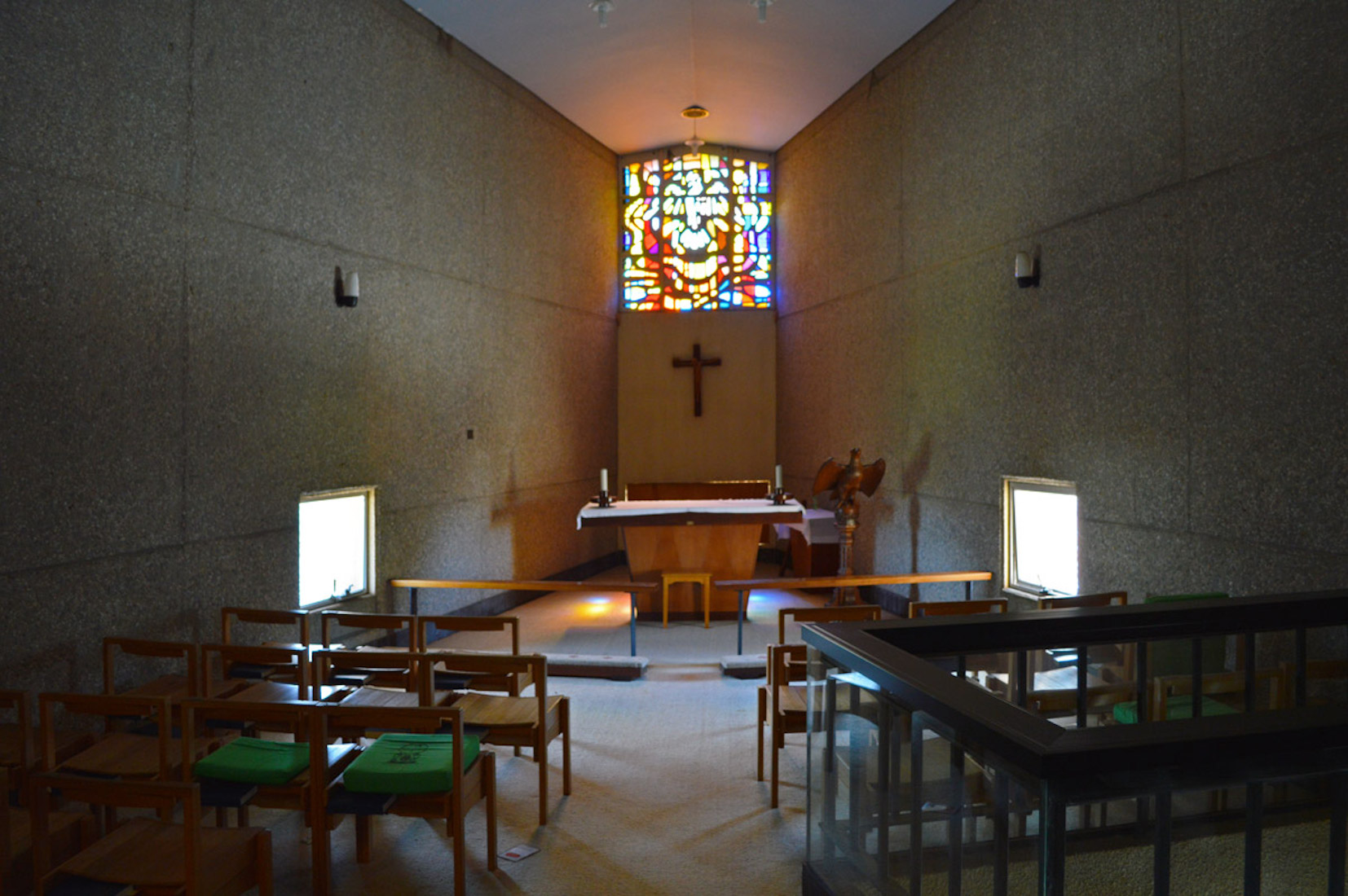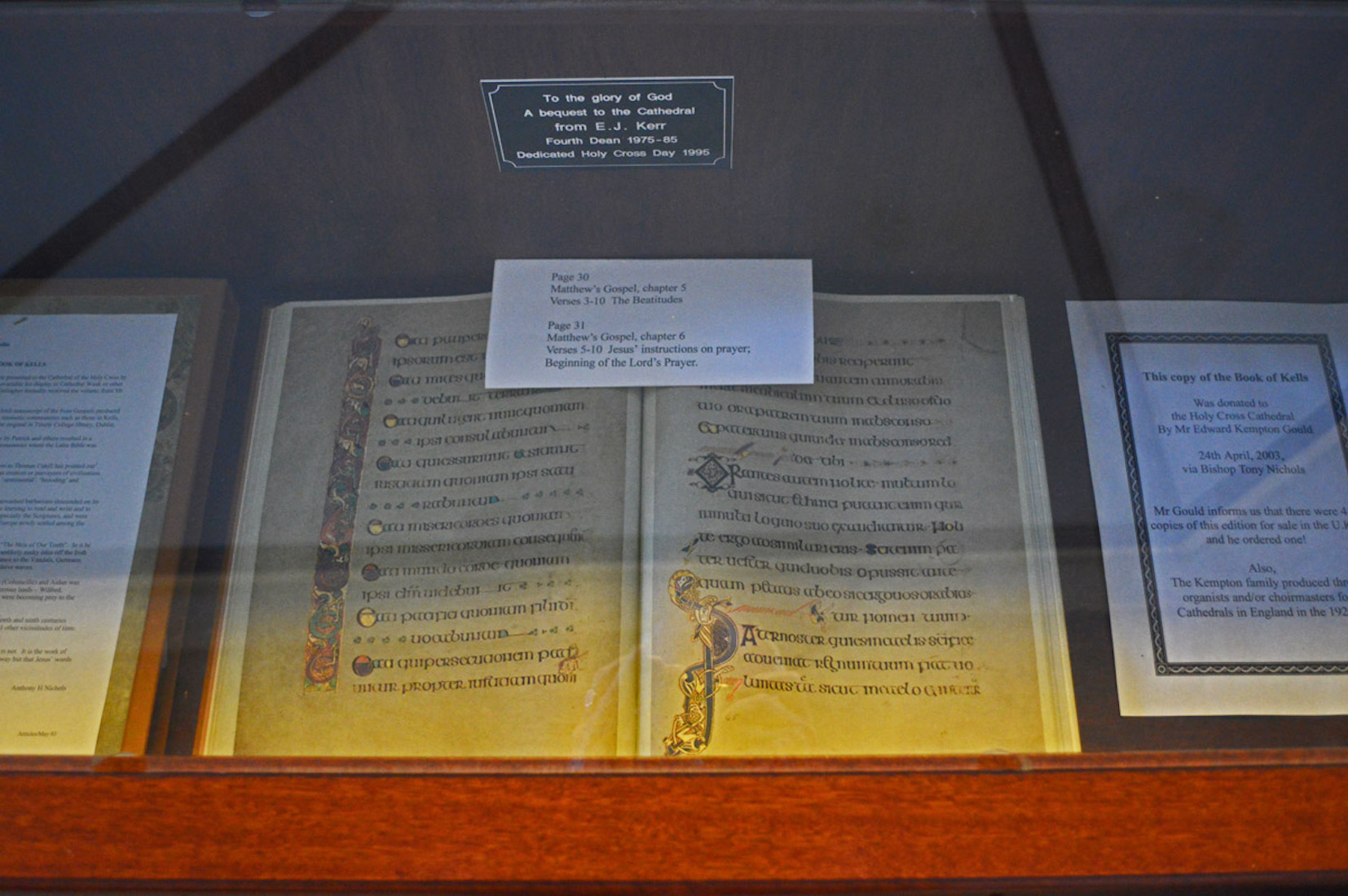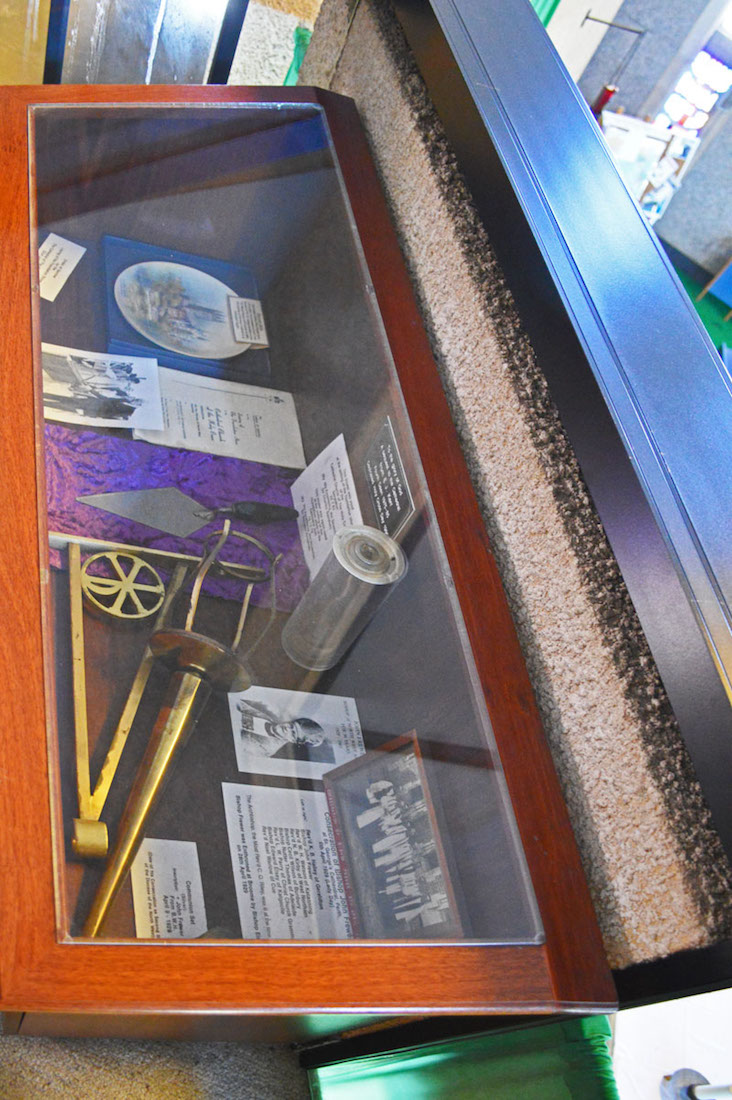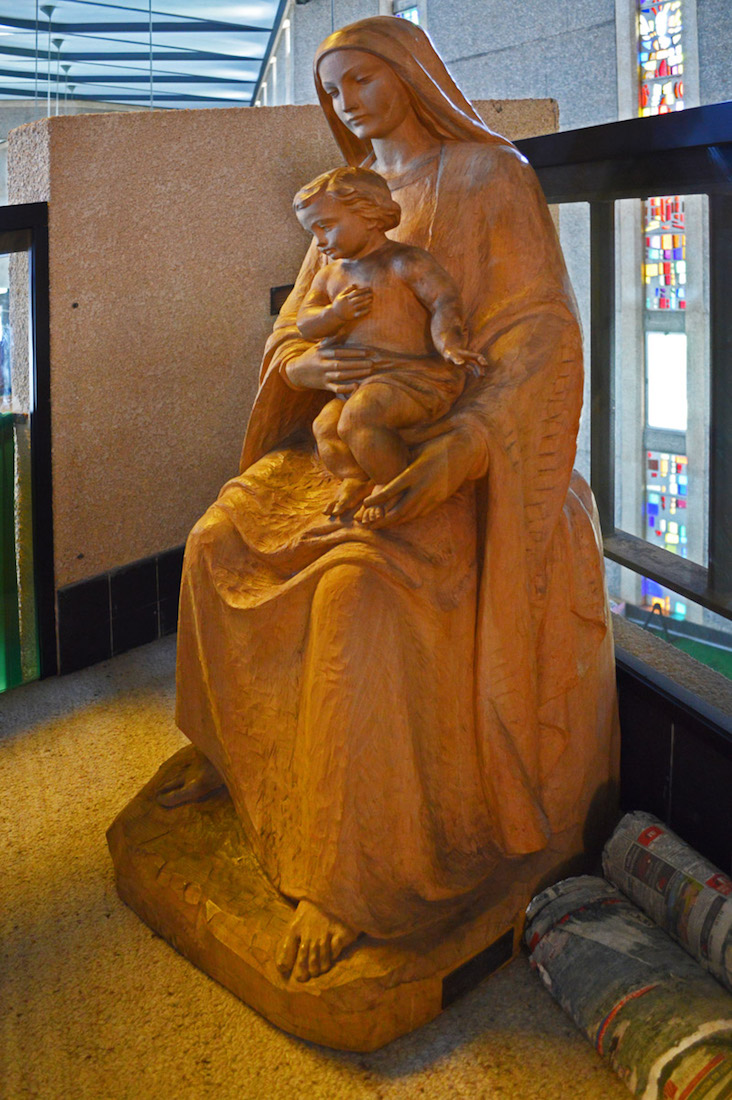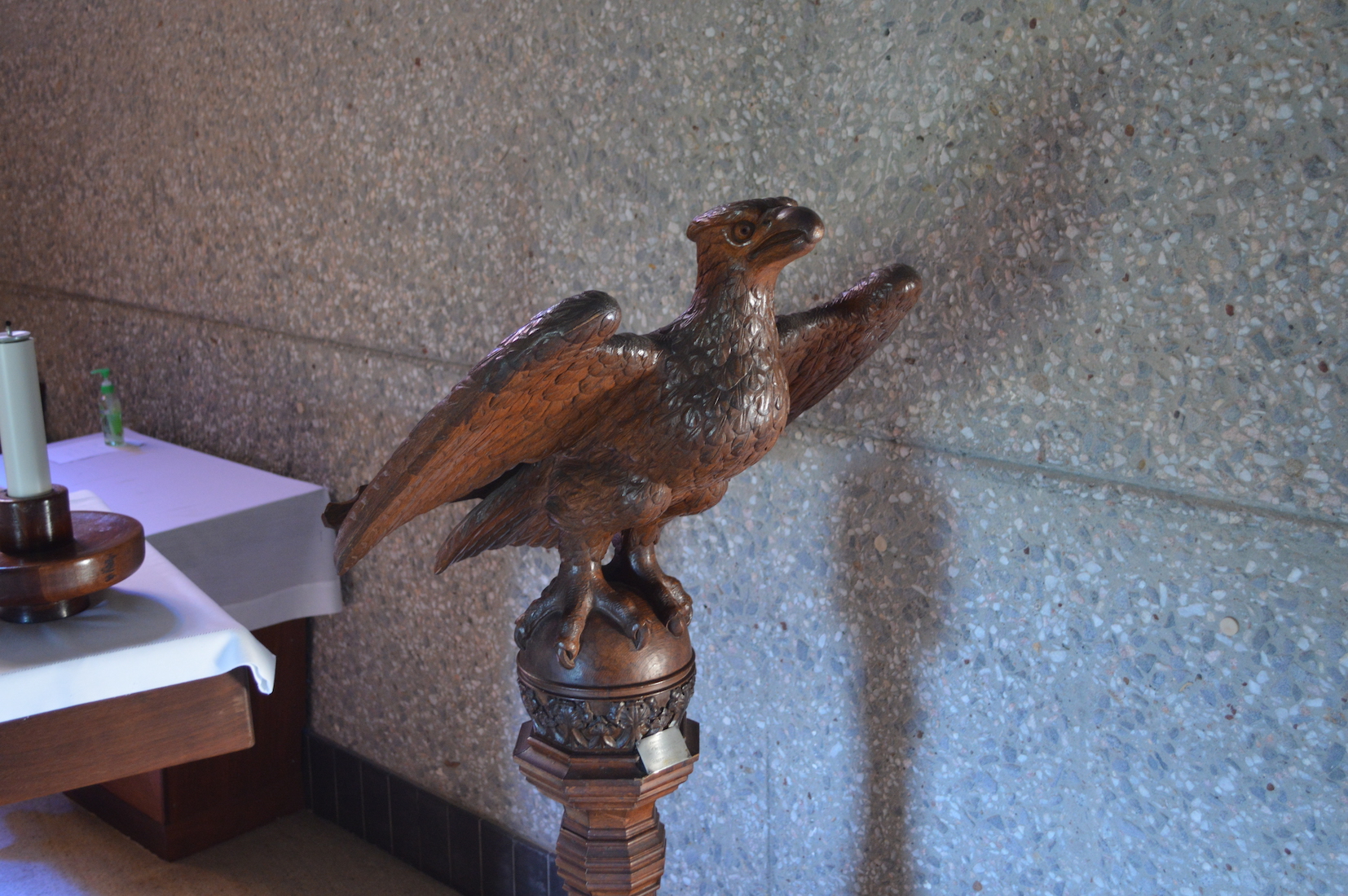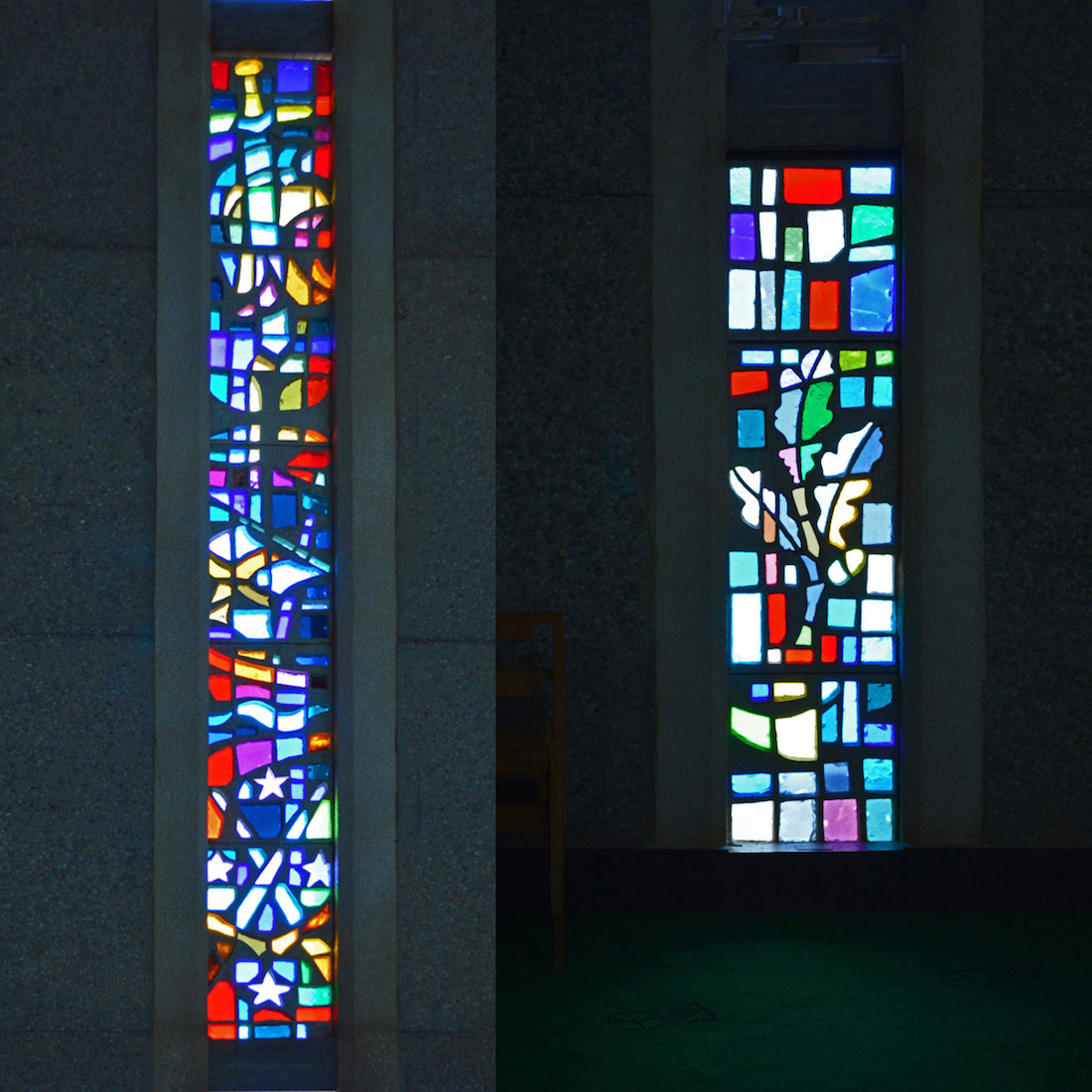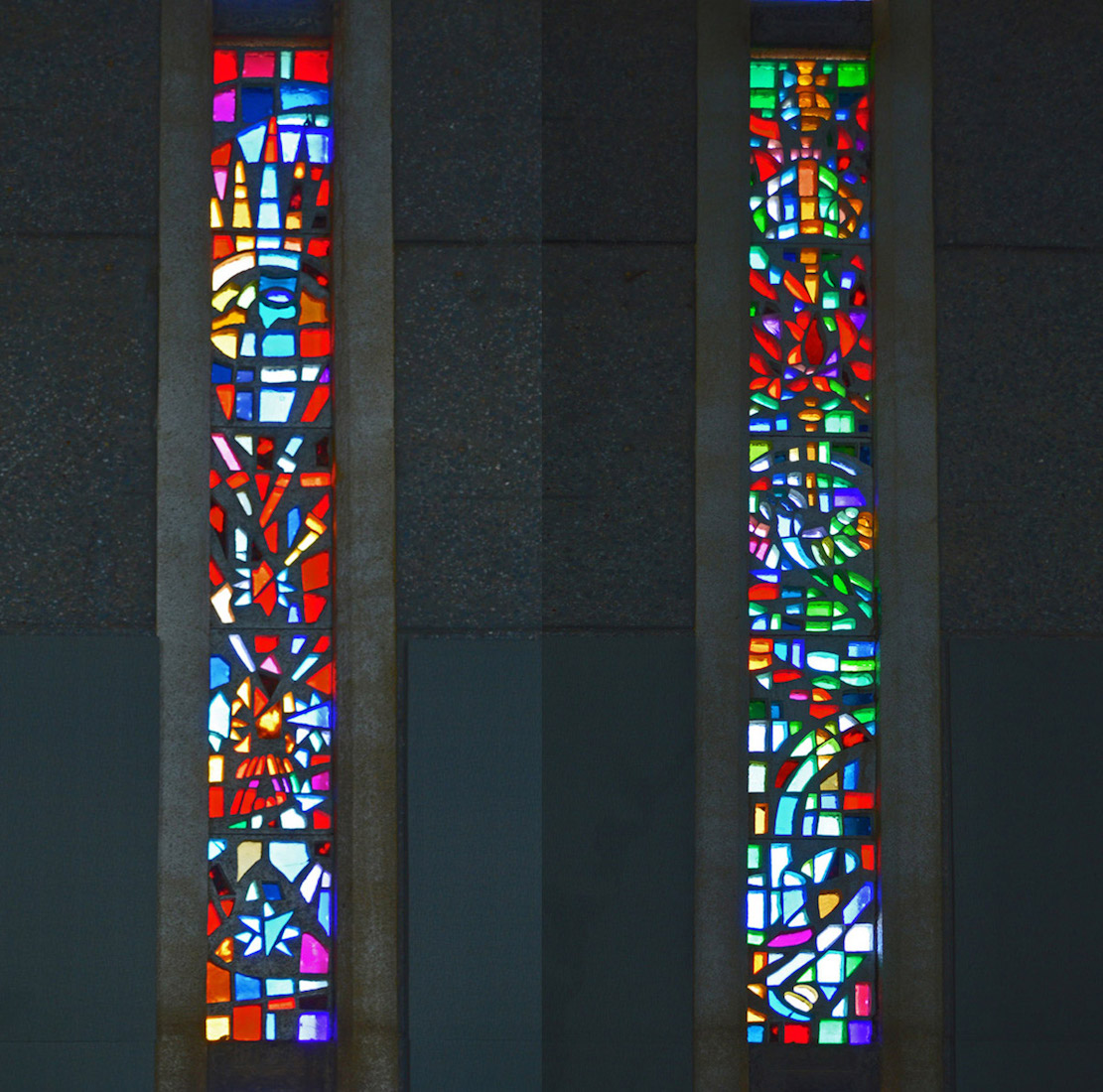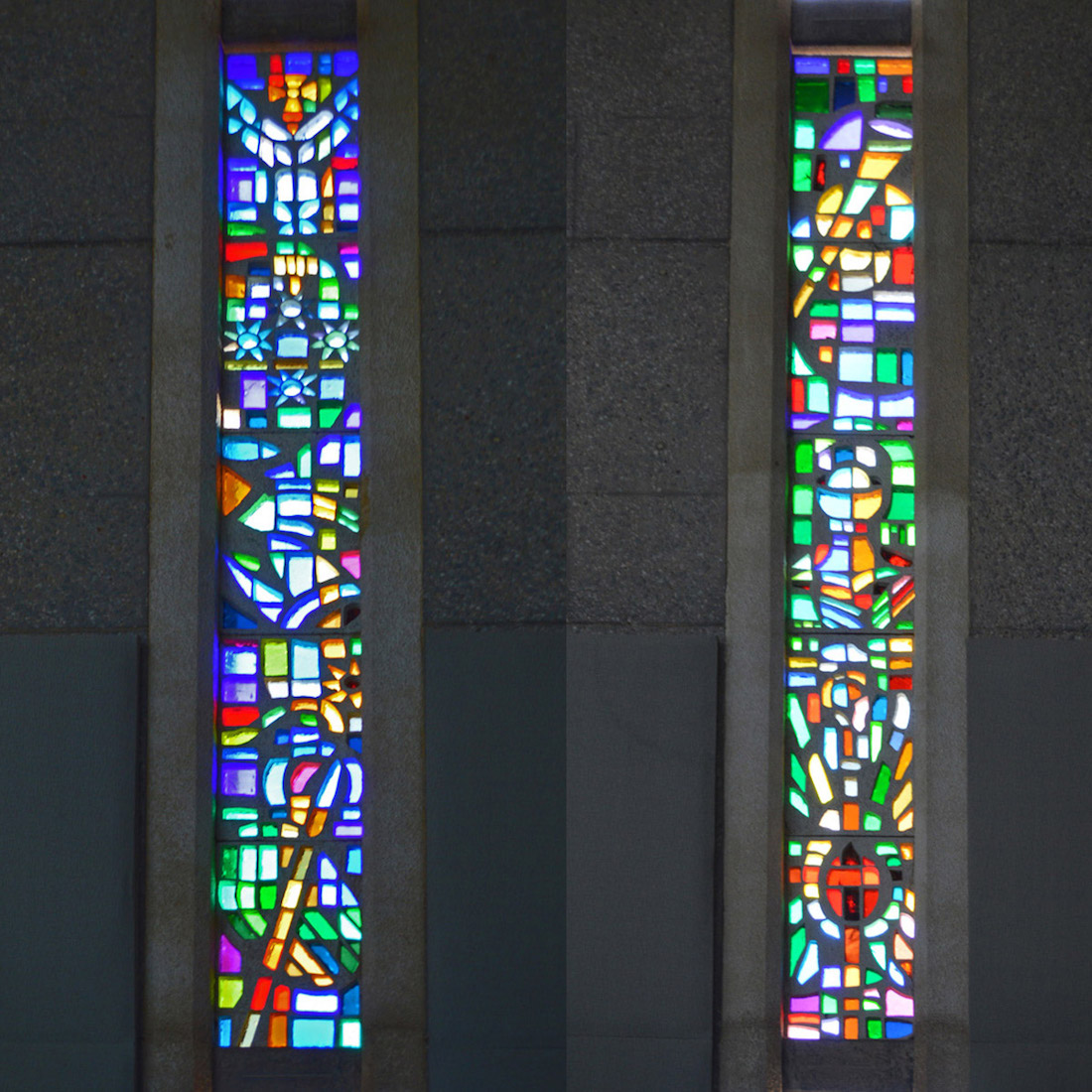
The carving at the centre of the Wooden Lord’s Table is the familiar IHS. This is a common Christogram based on the first three letters of ‘Jesus’ in Greek (Ίησους, in Greek capitals ΙΗΣΟΥΣ, or Latinized ΙΗSΟΥS). PLAN
22. CATHEDRA

Close by is the rather simple bishop’s chair (cathedra) [13] with the crest of the diocese. This is used at ordinations and other special services conducted by the bishop. A concrete bishop’s throne once stood directly behind the altar. The Church of England Diocese of North West Australia was inaugurated in 1910 by the endowment of a bishopric and appointment of the first bishop. The diocese did not have a cathedral, and Bishop Trower was enthroned in St George’s Church, Carnarvon in 1910. The bishop was heard to say that he had to ‘carry his stool about with him’. It was 54 years before this Cathedral was built. In keeping with Canterbury Cathedral, the bishop’s throne was built into the concrete wall behind the Lord’s table. The wall (and throne) was dismantled in 2009.
23. BISHOP’S CREST
This is the Coat of Arms of the Anglican Diocese of North West Australia. The Coat of Arms has been in use since the early history of the Diocese, but it was not until the 5th December 1956 that the Diocese received a grant of arms. A gold cross divides four sections, which contain the four stars of the Southern Cross, a mother of pearl shell, a spear and a boomerang, and a black swan. These represent, in order, the nation of Australia, the pearling industry of the original See town of Broome, the Aborigines of the North West, and the State of Western Australia signified by the Black Swan.
24. CROSS
The cream cross [14] on the screen behind the altar is known as a ‘cross pattée’. This is a cross which has arms narrow at the centre, and broader at the perimeter. The form appears very early in medieval art, for example in a metalwork treasure binding given to Monza Cathedral by Queen Theodelinda (d. 628), and the 8th century lower cover of the Lindau Gospels in the Morgan Library. The cross pattée is sometimes associated with the Crusader order, the Knights Templar. It is also placed before the name of the bishop who issues a Catholic imprimatur, and is occasionally found as a map symbol indicating the location of a Christian site. I do not know why it was chosen for this Cathedral.
25. LORD’S TABLE
The central altar [15] is described in Cathedral literature as ‘The Lord’s Table’. This is a common Protestant designation, and is used here despite the solid masonry construction hidden by the drapes.
26. LOGO
I can find no description of the Logo displayed at the front of the Lord’s Table, but a reasonable interpretation might be as follows. The central Cross replicates the cross on the wall behind – a variant of the traditional Christian symbol. The dove above signifies the Holy Spirit, with rays of light illuminating the Cross. The white trefoil represents the three Persons of the Trinity and God’s eternal nature. At the base we have the Alpha and Omega – the description of Christ from Revelation as ‘the Beginning and the End’ (Rev 21:6).
27. LORD’S TABLE DETAIL
Peeping beneath the Lord’s Table, we see its solid concrete construction. The two legs contain stones and pearls taken from parishes in existence when the Cathedral was built, so that the whole of the Diocese of North West Australia is represented.
28. SANCTUARY LAMP
On either side of the East Wall facing the Sanctuary is a small hanging light. I won’t hazard a guess concerning the meaning of the design of these little lights!
29. UPSTAIRS CHAPEL
Behind the screen back of the altar, and in the centre, we come to a narrow flight of stairs leading upwards. At the top we may be surprised to discover an intimate little chapel. It appears that originally this was to be called the Lady Chapel, but now it is designated simply as ‘The Chapel’ or ‘The Upstairs Chapel’.
30. CREATION WINDOW
Set in the East wall of the chapel, the Creation Window [20] is perhaps the most striking of the Cathedral windows. It depicts the Spirit of God moving upon the face of the waters – a dove, with wavy lines below. This window is a focus from almost any point of the cathedral.
31. CRUCIFIX
Below the Creation Window is a carved wooden Crucifix [20]. The figure of Christ was carved in Italy and mounted on a Cross of Western Australian jarrah.
32. CANTERBURY STONE
The Cathedral contains four stones from English cathedrals, two of which occur up in the Chapel [17, 19]. These are the Canterbury Stone taken from Canterbury Cathedral, 11th Century, and Mother Church of Anglican Communion [shown here], and the Westminster Stone, a stone from Westminster Abbey, 13th Century, a carved stone originally from the County of Sussex.
33. KERR CABINET I
The Kerr cabinets [18]. These are placed against the West dividing partition of the chapel. They were given in memory of the late John Kerr, a one time Dean of the Cathedral. This is an illuminated manuscript of the Gospel of Matthew.
34. KERR CABINET II
The Kerr cabinets in the chapel contain various items of historical interest.
35. MADONNA AND CHILD
This wooden sculpture of Madonna and Child [19] is sited at the North West corner of the Upstairs Chapel. This figure was carved from solid pine in Italy. It appears to be the only item in the Chapel which reflects the early intent of it being called the Lady Chapel. All the ornaments/furnishings of the Cathedral were either donated as outright gifts or as memorials. The sculpture is bathed in amber light from the Cathedral skylight.
36. EAGLE LECTERN
We now descend the stairs, leaving behind us the chapel. In the South East corner of the main auditorium we find the beautifully carved eagle lectern [22[. This came from Christ Church, the previous Anglican church in Geraldton. That church was built in 1868–69 and demolished in 1962. It once stood in Marine Terrace where the Bankwest building now stands.
37. SOUTH WINDOWS I
The window at left is the Abraham, Moses, Isaiah Window [23]. God’s presence is signified by the red glass at the very top. Below this the hand of Abraham holds a knife, ready to sacrifice his son Isaac. Below this is the ram provided by God as a substitute. The central panel represents the Ten Commandments given to Moses. The bottom panels show the letters IHS, a Greek symbol for Jesus, in radiating circles denoting widening belief in the Suffering Servant of Isa 53. At right is the St John the Baptist, St Stephen, St Paul Window [24]. From the top, the scallop shell refers to baptism, and the shoe to Mark 1:7–11. The hand holding two stones reminds us of the stoning of Stephen. At bottom, the sword of Paul’s martyrdom has the Cross as background, and the open book is the Word of God.
38. SOUTH WINDOWS II
This is the Window of St Alban, St Augustine of Canterbury, St Boniface [25]. Alban was the first Christian martyr to die in England, indicated here by the Roman helmet and short sword at top. Below, the ship with a cross on its sail marks the arrival of St Augustine in England in 597 AD. At bottom, the Diocesan crest of Bunbury, Boniface’s borough, has four stars and two swords. Each of the cathedral windows has a separate bottom panel. For this window, the bottom panel is shown at right: an oak leaf symbol of Boniface’s zeal and courage.
39. SOUTH WINDOWS III
• The Spirit of Sacrifice Window [26]. The colouring of the window at left reflects the shed blood of the martyrs. At the head is the spiked crown of martyrdom on a bed of thorns. Below we see praying hands surrounded by the Southern Cross below a flame, symbols of martyrdom and a red Cross of sacrifice, all pierced by bayonets symbolizing destruction of life in war. • Thomas Cranmer, Richard Hooker, George Herbert Window [27]. Cranmer contributed to liturgy through the Book of Common Prayer. His crozier (staff) is surmounted by an orb, not a cross, and the mitre in flames symbolizes his martyrdom. George Herbert was noted for his piety, hymn writing and poetry, symbolized by the quill, inkstand and scroll. Hooker’s work in theology is symbolized in the lower panel (not pictured).
40. WINDOWS IV
• The Arms of Canterbury, Bishop Broughton, Archdeacon Wollaston Window [28]. The head of the left window shows part of the Arms of the See of Canterbury and the See of Sydney, and the symbol beneath represents the consecration of Bishop Broughton as first Bishop of Australia in 1836. At the base, a horseshoe and spur marks the extensive travel on horseback by Archdeacon Wollaston and his work amongst aborigines by the shield and spear. • Bishop Trower, Archdeacon Simpson, Bishop Frewer Window [29]. The head of the window shows a trumpet and cymbal (Psalm 150) for the proclamation of the Gospel in the North West by Bishop Trower. Archbishop Simpson is represented by a chalice, Bible and stole. John Frewer is depicted as the Flying Bishop.


